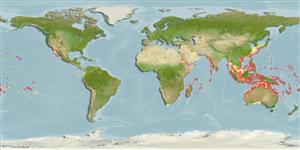Common names from other countries
分類 / Names
共通名の | 類義語 | Catalog of Fishes(部類, 種) | ITIS | CoL | WoRMS | Cloffa
Environment: milieu / climate zone / depth range / distribution range
生態学
海; 汽水性の 関連する礁; 深さの範囲 0 - 10 m (Ref. 86942), usually 0 - 10 m (Ref. 37816). Tropical; 40°N - 40°S
Indo-Pacific: East Africa to the Hawaiian, Marquesan, and Mangaréva islands, north to southern Japan, south to northern New South Wales, Australia. Also recorded from Southeast Atlantic: South Africa (Ref. 3972).
サイズ / 重さ / 年齢
Maturity: Lm ? range ? - ? cm
Max length : 66.0 cm TL オス/雌雄の選別がない; (Ref. 1602)
背面の脊椎 (合計) : 0; 背鰭 (合計) : 0; 肛門の骨: 0; 臀鰭: 0; 脊つい: 162 - 171. White to yellow with 25-30 black saddles (Ref. 3972).
Occurs in sandy areas and seagrass beds of both lagoon and seaward reefs. Uses its stiff pointed tail to rapidly burrow backwards into the sand when frightened (Ref. 37816). Benthic (Ref. 58302). Feeds on sand-dwelling fishes and crabs and prawns. Sometimes fully exposed when searching for prey (Ref. 30874). Rises to the surface to spawn (Ref. 37816).
Life cycle and mating behavior
Maturities | 繁殖 | Spawnings | Egg(s) | Fecundities | 幼生
Rises to the surface to spawn. Once there, one or more males may seize a female by the back of the neck and remain attached for hours before spawning occurs.
Myers, R.F., 1991. Micronesian reef fishes. Second Ed. Coral Graphics, Barrigada, Guam. 298 p. (Ref. 1602)
CITES (Ref. 128078)
Not Evaluated
Human uses
用具
特記事項
XMLをダウンロードして下さい
インターネットの情報源
Estimates based on models
Preferred temperature (Ref.
115969): 24.4 - 29.2, mean 28.1 (based on 2893 cells).
Phylogenetic diversity index (Ref.
82804): PD
50 = 0.7500 [Uniqueness, from 0.5 = low to 2.0 = high].
Bayesian length-weight: a=0.00089 (0.00039 - 0.00204), b=3.00 (2.80 - 3.20), in cm Total Length, based on LWR estimates for this (Sub)family-body shape (Ref.
93245).
栄養段階 (Ref.
69278): 3.1 ±0.3 se; based on diet studies.
回復力 (Ref.
120179): 手段, 1.4年~4.4年の倍増期間の最小個体群 (Preliminary K or Fecundity.).
Fishing Vulnerability (Ref.
59153): Moderate to high vulnerability (46 of 100).
